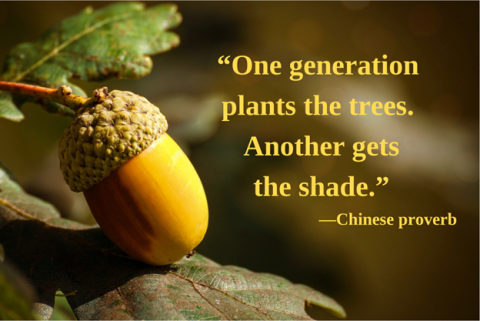Shade Matters

There’s nothing like the hottest summer ever recorded on earth to remind us all that shade matters. As I write this, here in our little corner of New Hampshire the days are running some seven degrees warmer than average this week alone. In my garden, even the plants that typically require full sun are suffering; the ones shaded by trees and shadowed by structures are coping much better.
There’s a simple reason for this: Shade is a critical factor in ameliorating high temperatures, conserving energy, preserving habitat and wildlife, and saving lives.
A Matter of Degrees
The effects of shade on the air around us is formidable. Shade can lower the ambient temperature of the air by as much as 15 to 20 degrees. It has a similar cooling effect on the surface temperatures of buildings; shaded surfaces may run between 20 to 45 degrees cooler than they would if left unshaded. Even in cities with dense development, areas with trees are 2.9 degrees cooler than areas without trees.
In addition to lowering surface and air temperatures, trees and vegetation also help regulate temperature by evapotranspiration, that is, the way they process precipitation. When rain falls onto leaves and soil, it evaporates. Through their roots, trees absorb water from the soil, pull it up through the plant to the leaves, which release the excess as vapor into the air. For example, a large oak tree transpires as much as 40,000 gallons of water vapor a year.
How and Where to Make Shade
Consider leaf-bearing trees, which provide shade in the warmer months and allow the sun to shine through their bare branches in the cooler months, when we appreciate the added warmth. Here in the northern hemisphere, planting deciduous trees along southern and western exposures can help shade houses and other buildings from the morning and midday sun, and the afternoon and setting sun, respectively. Generally speaking, the taller the tree and the larger the crown, the better. Be sure to consult with an arborist on the best size tree for your space, and be prepared to maintain your trees as needed.
- Plant trees along driveways and sidewalks, which will help counteract the “heat island” effect of all that asphalt and concrete.
- Plant a tree or two wherever people gather in your yard, like around patios, playgrounds, and picnic areas.
- Use trees as the central elements in the plant guilds on your property. A well-planned plant guild is a community of plants that work together to feed and build the soil, conserve water, attract insects and pollinators, repel weeds, pests, and disease, and prevent erosion—and provide much-needed shade. Fruit and nut trees are particularly good.
- If you have an outside air-conditioning unit, positioning it on the shadiest side of the house, and/or planting a shade tree can help the unit run most efficiently. Plant the tree at least 5-15 feet away from the AC unit to keep leaves and branches from obstructing it.
- Make yours a green roof. These “living roofs” are rooftops covered with soil and vegetation. Increasingly popular in urban areas, green roofs not only reduce the ambient temperature, they serve as rainwater buffers and air purifiers. They also save energy and biodiversity. By retaining much of the precipitation that falls on them all year round, they can also help prevent flooding.

The Future’s So Bright We’re Gonna Need More Shade
Given climate change, the more shade, the better. This means more trees, trees, and more trees. To wit: We need to plant more trees, in our yards, in our towns, in our communities, and in the world at large.
Best Shade Trees to Plant for Climate Change
- Oak
- Maple
- Serviceberry
- American Linden
- Tulip Poplar
- Flowering Dogwood
- Honey Locust
So, go ahead. Plant a tree. Or two. Or an orchard full.
Do it to stay cool. Do it to save the planet. But most of all, do it because, as Joyce Kilmer wrote, “I think that I shall never see, A poem lovely as a tree.” Or as he wrote in the last couplet—admittedly my favorite lines—“Poems are made by fools like me, But only God can make a tree.”
May your summer be full of shade,
Paula
Information sourced from Emma Martone, curator of the Mariana H Qubein Arboretum and Botanical Gardens at High Point University in North Carolina. https://www.homesandgardens.com/gardens/best-trees-for-climate-change